Soil Quality Assessment and Influencing Factors of Different Land Use Types in Red Bed Desertification Regions: A Case Study of Nanxiong, China
Abstract
:1. Introduction
2. Materials and Methods
2.1. Overview of the Study Area
2.2. Soil Sample Collection
2.3. Soil Sample Experimental Methods
2.4. Soil Quality Evaluation Methods
2.5. Data Analysis
3. Results
3.1. Characteristics of Red Bed Soil in Different Land Use Types
3.2. Correlation Analysis of Soil Quality Indices
3.3. Establishment of MDS Based on Principal Component Analysis
3.4. Soil Quality Index Based on TDS and MDS
3.5. Validate the Applicability of MDS
4. Discussion
4.1. The MDS for Soil Quality Assessment in Humid Red Bed Basins
4.2. Soil Quality Characteristics and Influencing Factors of Different Land Use Types in the Red Bed Region
4.3. Soil Quality Improvement Recommendations for Red Bed Desertification Areas
5. Conclusions
Author Contributions
Funding
Data Availability Statement
Conflicts of Interest
References
- Yan, L.-B.; Kasanin-Grubin, M. Land degradation and management of red beds in China: Two case studies. J. Mt. Sci. 2019, 16, 2591–2604. [Google Scholar] [CrossRef]
- Guo, Y.; Xie, Q.; Wen, J. Red beds distribution and engineering geological problem in China. Hydrogeol. Eng. Geol. 2007, 6, 67–71. [Google Scholar] [CrossRef]
- Zhao, J.; He, X.; Shao, T. Material composition and microstructure of purple soil and purple mudstone in Chongqing area. Acta Pedol. Sin. 2012, 49, 212–219. [Google Scholar]
- Jin, Y.; Peng, H.; Yan, L.; Xiang, Y.; Wang, X. Discussion on desertification of humid region in southern China. Prog. Geogr. 2015, 34, 772–780. [Google Scholar] [CrossRef]
- Peng, H. Perspectives on the red beds landforms in humid area of southern China and some related problems. Geogr. Res. 2011, 30, 1739–1752. [Google Scholar] [CrossRef]
- Doran, J.W.; Parkin, T.B. Defining and assessing soil quality. Defin. Soil Qual. A Sustain. Environ. 1994, 35, 1–21. [Google Scholar]
- Ditzler, C.A.; Tugel, A.J. Soil quality field tools: Experiences of USDA-NRCS soil quality institute. Agron. J. 2002, 94, 33–38. [Google Scholar] [CrossRef]
- Karlen, D.L.; Ditzler, C.A.; Andrews, S.S. Soil quality: Why and how? Geoderma 2003, 114, 145–156. [Google Scholar] [CrossRef]
- Pierce, F.; Larson, W.; Dowdy, R.; Graham, W. Productivity of soils: Assessing long-term changes due to erosion. J. Soil Water Conserv. 1983, 38, 39–44. [Google Scholar]
- Bünemann, E.K.; Bongiorno, G.; Bai, Z.; Creamer, R.E.; De Deyn, G.; De Goede, R.; Fleskens, L.; Geissen, V.; Kuyper, T.W.; Mäder, P. Soil quality—A critical review. Soil Biol. Biochem. 2018, 120, 105–125. [Google Scholar] [CrossRef]
- Huang, T.; Yue, X.; Ge, X.; Wang, X. Evaluation of soil quality on gully region of loess plateau based on principal component analysis. Agric. Res. Arid. Areas 2010, 28, 141–147. [Google Scholar]
- Shao, G.; Ai, J.; Sun, Q.; Hou, L.; Dong, Y. Soil quality assessment under different forest types in the Mount Tai, central Eastern China. Ecol. Indic. 2020, 115, 106439. [Google Scholar] [CrossRef]
- Yu, P.; Han, D.; Liu, S.; Wen, X.; Huang, Y.; Jia, H. Soil quality assessment under different land uses in an alpine grassland. Catena 2018, 171, 280–287. [Google Scholar] [CrossRef]
- Zhang, X.; Kong, F.; Jiang, Z. Construction and empirical analysis of a comprehensive evaluation method of coastal wetland soil quality based on ecological functions. Environ. Sci. 2022, 43, 2709–2718. [Google Scholar] [CrossRef]
- Maurya, S.; Abraham, J.S.; Somasundaram, S.; Toteja, R.; Gupta, R.; Makhija, S. Indicators for assessment of soil quality: A mini-review. Environ. Monit. Assess. 2020, 192, 604. [Google Scholar] [CrossRef] [PubMed]
- Abraham, J.S.; Sripoorna, S.; Dagar, J.; Jangra, S.; Kumar, A.; Yadav, K.; Singh, S.; Goyal, A.; Maurya, S.; Gambhir, G. Soil ciliates of the Indian Delhi Region: Their community characteristics with emphasis on their ecological implications as sensitive bio-indicators for soil quality. Saudi J. Biol. Sci. 2019, 26, 1305–1313. [Google Scholar] [CrossRef] [PubMed]
- Moral, F.J.; Rebollo, F.J. Characterization of soil fertility using the Rasch model. J. Soil Sci. Plant Nutr. 2017, 17, 486–498. [Google Scholar] [CrossRef]
- Liu, Z.-P.; Shao, M.-A.; Wang, Y.-Q. Spatial patterns of soil total nitrogen and soil total phosphorus across the entire Loess Plateau region of China. Geoderma 2013, 197, 67–78. [Google Scholar] [CrossRef]
- Das, P.P.; Singh, K.R.; Nagpure, G.; Mansoori, A.; Singh, R.P.; Ghazi, I.A.; Kumar, A.; Singh, J. Plant-soil-microbes: A tripartite interaction for nutrient acquisition and better plant growth for sustainable agricultural practices. Environ. Res. 2022, 214, 113821. [Google Scholar] [CrossRef]
- Luo, X.; Zhang, L.; Lin, Y.; Wen, D.; Hou, E. Nitrogen availability mediates soil organic carbon cycling in response to phosphorus supply: A global meta-analysis. Soil Biol. Biochem. 2023, 185, 109158. [Google Scholar] [CrossRef]
- Soumare, A.; Djibril, S.; Diédhiou, A.G. Potassium sources, microorganisms and plant nutrition: Challenges and future research directions. Pedosphere 2023, 33, 105–115. [Google Scholar] [CrossRef]
- Ciais, P.; Gervois, S.; Vuichard, N.; Piao, S.; Viovy, N. Effects of land use change and management on the European cropland carbon balance. Glob. Chang. Biol. 2011, 17, 320–338. [Google Scholar] [CrossRef]
- Cotrufo, M.F.; Lavallee, J.M. Soil organic matter formation, persistence, and functioning: A synthesis of current understanding to inform its conservation and regeneration. Adv. Agron. 2022, 172, 1–66. [Google Scholar]
- O’Sullivan, L.; Bampa, F.; Knights, K.; Creamer, R. Soil protection for a sustainable future: Options for a soil monitoring network for Ireland. Soil Use Manag. 2017, 33, 346–363. [Google Scholar] [CrossRef]
- Bertini, S.C.B.; Azevedo, L.C.B.; de Carvalho Mendes, I.; Cardoso, E.J.B.N. Hierarchical partitioning for selection of microbial and chemical indicators of soil quality. Pedobiologia 2014, 57, 293–301. [Google Scholar] [CrossRef]
- Jin, H.; Shi, D.; Chen, Z.; Liu, Y.; Lou, Y.; Yang, X. Evaluation indicators of cultivated layer soil quality for red soil slope farmland based on cluster and PCA analysis. Trans. Chin. Soc. Agric. Eng. 2018, 34, 155–164. [Google Scholar] [CrossRef]
- Chen, J.; Fu, J.; Xu, G.; Yu, B.; Lai, X.; Hu, S.; Zhang, K.; Liu, J. Soil Quality Characteristics and Influencing Factors of Different Land Use in the Red Bed Landform Region of South China: Taking Nanxiong Basin as An Example. Ecol. Environ. 2022, 31, 918. [Google Scholar] [CrossRef]
- Yan, P.; Lin, K.; Wang, Y.; Tu, X.; Bai, C.; Yan, L. Assessment of influencing factors on the spatial variability of SOM in the red beds of the Nanxiong basin of China, using GIS and geo-statistical methods. ISPRS Int. J. Geo-Inf. 2021, 10, 366. [Google Scholar] [CrossRef]
- Yan, P.; Lin, K.; Wang, Y.; Zheng, Y.; Gao, X.; Tu, X.; Bai, C. Spatial interpolation of red bed soil moisture in Nanxiong basin, South China. J. Contam. Hydrol. 2021, 242, 103860. [Google Scholar] [CrossRef]
- Wu, Z.; Peng, H. A study on the formation and development rules of the red beds in Guangdong Province. Trop. Geogr. 2006, 26, 207. [Google Scholar]
- Shen, W.-S.; Cao, X.-Z.; Shen, F.-Y. Classification and grading of land degradation in China. J. Ecol. Rural. Environ. 2006, 22, 88–93. [Google Scholar]
- Lu, R. Soil Agrochemical Analytical Methods; Chinese Agriculture and Technology Press Publisher: Beijing, China, 1999. [Google Scholar]
- Walkley, A.; Black, I.A. An examination of the Degtjareff method for determining soil organic matter, and a proposed modification of the chromic acid titration method. Soil Sci. 1934, 37, 29–38. [Google Scholar] [CrossRef]
- Anderson, J.M.; Ingram, J.S. Tropical soil biology and fertility: A handbook of methods. Soil Sci. 1994, 157, 265. [Google Scholar] [CrossRef]
- Schmugge, T.; Jackson, T.; McKim, H. Survey of methods for soil moisture determination. Water Resour. Res. 1980, 16, 961–979. [Google Scholar] [CrossRef]
- Bray, R.H.; Kurtz, L.T. Determination of total, organic, and available forms of phosphorus in soils. Soil Sci. 1945, 59, 39–46. [Google Scholar] [CrossRef]
- Schollenberger, C.; Simon, R. Determination of exchange capacity and exchangeable bases in soil—Ammonium acetate method. Soil Sci. 1945, 59, 13–24. [Google Scholar] [CrossRef]
- Norvell, W.; Lindsay, W. Reactions of DTPA chelates of iron, zinc, copper, and manganese with soils. Soil Sci. Soc. Am. J. 1972, 36, 778–783. [Google Scholar] [CrossRef]
- Rinot, O.; Levy, G.J.; Steinberger, Y.; Svoray, T.; Eshel, G. Soil health assessment: A critical review of current methodologies and a proposed new approach. Sci. Total Environ. 2019, 648, 1484–1491. [Google Scholar] [CrossRef] [PubMed]
- Wu, C.; Liu, G.; Huang, C.; Liu, Q. Soil quality assessment in Yellow River Delta: Establishing a minimum data set and fuzzy logic model. Geoderma 2019, 334, 82–89. [Google Scholar] [CrossRef]
- Zhang, F.; Gao, Z.; Ma, Q.; Song, Z.; Li, G.; Li, X.; Su, Y. Construction of minimum data set for soil quality assessment in the Dunhuang Oasis. Chin. J. Soil Sci. 2017, 48, 1047–1054. [Google Scholar]
- Jin, H.; Zhong, Y.; Shi, D.; Li, J.; Lou, Y.; Li, Y.; Li, J. Quantifying the impact of tillage measures on the cultivated-layer soil quality in the red soil hilly region: Establishing the thresholds of the minimum data set. Ecol. Indic. 2021, 130, 108013. [Google Scholar] [CrossRef]
- Chen, Y.; Wang, H.; Zhou, J.-M.; Xing, L.; Zhu, B.; Zhao, Y.; Chen, X. Minimum data set for assessing soil quality in farmland of northeast China. Pedosphere 2013, 23, 564–576. [Google Scholar] [CrossRef]
- Computer Network Information Center, C.A.o.S. ASTER GDEM 30M Resolution Digital Elevation Data. Available online: https://www.gscloud.cn/sources/index?pid=1&rootid=1 (accessed on 15 June 2024).
- Ministry of Natural Resources of the People’s Republic of China. China Standard Map (Revision No. GS (2024) 0650). Available online: https://cloudcenter.tianditu.gov.cn/administrativeDivision (accessed on 15 June 2024).
- Yu, P.; Liu, S.; Zhang, L.; Li, Q.; Zhou, D. Selecting the minimum data set and quantitative soil quality indexing of alkaline soils under different land uses in northeastern China. Sci. Total Environ. 2018, 616, 564–571. [Google Scholar] [CrossRef] [PubMed]
- Zhu, Z.; Chen, J.; Hu, H.; Zhou, M.; Zhu, Y.; Wu, C.; Zhu, L.; Jiang, X.; Wang, J. Soil quality evaluation of different land use modes in small watersheds in the hilly region of southern Jiangsu. Ecol. Indic. 2024, 160, 111895. [Google Scholar] [CrossRef]
- Cheng, J.; Ding, C.; Li, X.; Zhang, T.; Wang, X. Soil quality evaluation for navel orange production systems in central subtropical China. Soil Tillage Res. 2016, 155, 225–232. [Google Scholar] [CrossRef]
- Salazar, M.P.; Lozano, L.A.; Villarreal, R.; Irizar, A.B.; Barraco, M.; Polich, N.G.; Soracco, C.G. Capacity and Intensity Indicators to evaluate the effect of different crop sequences and cover crops on soil physical quality of two different textured soils from Pampas Region. Soil Tillage Res. 2022, 217, 105268. [Google Scholar] [CrossRef]
- Schoenholtz, S.H.; Van Miegroet, H.; Burger, J. A review of chemical and physical properties as indicators of forest soil quality: Challenges and opportunities. For. Ecol. Manag. 2000, 138, 335–356. [Google Scholar] [CrossRef]
- Bautista-Cruz, A.; Del Castillo, R.F.; Etchevers-Barra, J.D.; del Carmen Gutiérrez-Castorena, M.; Baez, A. Selection and interpretation of soil quality indicators for forest recovery after clearing of a tropical montane cloud forest in Mexico. For. Ecol. Manag. 2012, 277, 74–80. [Google Scholar] [CrossRef]
- Moharana, P.; Singh, R.; Singh, S.; Tailor, B.; Jena, R.; Meena, M. Development of secondary salinity and salt migration in the irrigated landscape of hot arid India. Environ. Earth Sci. 2019, 78, 454. [Google Scholar] [CrossRef]
- Pessoa, L.G.; Freire, M.B.d.S.; Green, C.H.; Miranda, M.F.; de A Filho, J.C.; Pessoa, W.R. Assessment of soil salinity status under different land-use conditions in the semiarid region of Northeastern Brazil. Ecol. Indic. 2022, 141, 109139. [Google Scholar] [CrossRef]
- Dos Santos, J.C.B.; Le Pera, E.; de Souza Junior, V.S.; Corrêa, M.M.; de Azevedo, A.C. Gneiss saprolite weathering and soil genesis along an east-west regolith sequence (NE Brazil). Catena 2017, 150, 279–290. [Google Scholar] [CrossRef]
- Câmara, E.R.G.; dos Santos, J.C.B.; de Araújo Filho, J.C.; Schulze, S.M.B.B.; Corrêa, M.M.; Ferreira, T.O.; de Sousa, J.E.S.; de Souza Júnior, V.S. Parent rock–pedogenesis relationship: How the weathering of metamorphic rocks influences the genesis of Planosols and Luvisols under a semiarid climate in NE Brazil. Geoderma 2021, 385, 114878. [Google Scholar] [CrossRef]
- Oliveira Filho, J.d.S.; Barrozo, M.V.d.S.; Bastos, F.d.H.; Pereira, M.G. Effects of climate and land-use on physicochemical properties of gneiss-derived soils in tropical drylands: Evidence from northeastern Brazil. Geoderma Reg. 2023, 33, e00639. [Google Scholar] [CrossRef]
- Dong, G.; Zhang, A.; Luo, G.; Xu, W.; Dai, L. Study on contents of available trace elements in oasis soil of Sangong river watershed. Soils 2009, 41, 726–732. [Google Scholar]
- Ge, Y.; Murray, P.; Hendershot, W. Trace metal speciation and bioavailability in urban soils. Environ. Pollut. 2000, 107, 137–144. [Google Scholar] [CrossRef]
- Thornton, I. Geochemistry and the mineral nutrition of agricultural livestock and wildlife. Appl. Geochem. 2002, 17, 1017–1028. [Google Scholar] [CrossRef]
- Liu, Z.; Zhu, F.Q.; Tang, L.; Xu, J.; Yen, C. Geographical distribution of trace element-deficient soils in China. Acta Pedol. Sin. 1982, 19, 209–223. [Google Scholar]
- Tian, K.; Zhang, B.; Zhang, H.; Huang, B.; Darilek, J.L.; Zhao, Y.; Yang, J. Evaluation of soil quality in major grain-producing region of the North China Plain: Integrating minimum data set and established critical limits. Ecol. Indic. 2020, 117, 106613. [Google Scholar] [CrossRef]
- Macedo, R.S.; Lima, R.P.; de Almeida Alves Carneiro, K.; Moro, L.; Refati, D.C.; Campos, M.C.C.; Beirigo, R.M.; da Cruz, G.K.G.; de Sousa, A.A.P.; de Brito Neto, J.F. Assessment of Soil Quality of Smallholder Agroecosystems in the Semiarid Region of Northeastern Brazil. Land 2024, 13, 304. [Google Scholar] [CrossRef]
- Cotrufo, M.F.; Haddix, M.L.; Kroeger, M.E.; Stewart, C.E. The role of plant input physical-chemical properties, and microbial and soil chemical diversity on the formation of particulate and mineral-associated organic matter. Soil Biol. Biochem. 2022, 168, 108648. [Google Scholar] [CrossRef]
- Xiao, K.; Li, D.; Wen, L.; Yang, L.; Luo, P.; Chen, H.; Wang, K. Dynamics of soil nitrogen availability during post-agricultural succession in a karst region, southwest China. Geoderma 2018, 314, 184–189. [Google Scholar] [CrossRef]
- Wang, X.; Liu, Z.; Xiong, K.; He, Q.; Li, Y.; Li, K. Characteristics and controlling factors of soil dissolved organic matter in the rainy season after vegetation restoration in a karst drainage area, South China. Catena 2022, 217, 106483. [Google Scholar] [CrossRef]
- Huang, S.; Peng, X.; Huang, Q.; Zhang, W. Soil aggregation and organic carbon fractions affected by long-term fertilization in a red soil of subtropical China. Geoderma 2010, 154, 364–369. [Google Scholar] [CrossRef]
- Zhang, H.; Wang, B.; Xu, M.; Fan, T. Crop yield and soil responses to long-term fertilization on a red soil in southern China. Pedosphere 2009, 19, 199–207. [Google Scholar] [CrossRef]
- Li, X.; Wang, D.; Ren, Y.; Wang, Z.; Zhou, Y. Soil quality assessment of croplands in the black soil zone of Jilin Province, China: Establishing a minimum data set model. Ecol. Indic. 2019, 107, 105251. [Google Scholar] [CrossRef]
- Jin, H.; Shi, D.; Lou, Y.B.; Zhang, J.; Ye, Q.; Jiang, N. Evaluation of the quality of cultivated-layer soil based on different degrees of erosion in sloping farmland with purple soil in China. Catena 2021, 198, 105048. [Google Scholar] [CrossRef]
- Gan, F.; Shi, H.; Yan, Y.; Pu, J.; Dai, Q.; Gou, J.; Fan, Y. Soil quality assessment of karst trough valley under different bedrock strata dip and land-use types, based on a minimum data set. Catena 2024, 241, 108048. [Google Scholar] [CrossRef]
- Huang, W.; Zong, M.; Fan, Z.; Feng, Y.; Li, S.; Duan, C.; Li, H. Determining the impacts of deforestation and corn cultivation on soil quality in tropical acidic red soils using a soil quality index. Ecol. Indic. 2021, 125, 107580. [Google Scholar] [CrossRef]
- Augusto, L.; Ranger, J.; Binkley, D.; Rothe, A. Impact of several common tree species of European temperate forests on soil fertility. Ann. For. Sci. 2002, 59, 233–253. [Google Scholar] [CrossRef]
- De Wit, H.A.; Eldhuset, T.D.; Mulder, J. Dissolved Al reduces Mg uptake in Norway spruce forest: Results from a long-term field manipulation experiment in Norway. For. Ecol. Manag. 2010, 259, 2072–2082. [Google Scholar] [CrossRef]
- Wright, R.; Baligar, V.; Ahlrichs, J. The influence of extractable and soil solution aluminum on root growth of wheat seedlings. Soil Sci. 1989, 148, 293–302. [Google Scholar] [CrossRef]
- Miao, L.; Moore, J.C.; Zeng, F.; Lei, J.; Ding, J.; He, B.; Cui, X. Footprint of research in desertification management in China. Land Degrad. Dev. 2015, 26, 450–457. [Google Scholar] [CrossRef]
- Sui, H.; Song, G.; Liu, W.; Zhang, Y.; Su, R.; Wang, Q.; Ren, G.; Mi, Y. Spatiotemporal variation of cultivated land ecosystem stability in typical regions of Lower Liaohe Plain China based on stress-buffer-response. Sci. Total Environ. 2023, 858, 160213. [Google Scholar] [CrossRef] [PubMed]
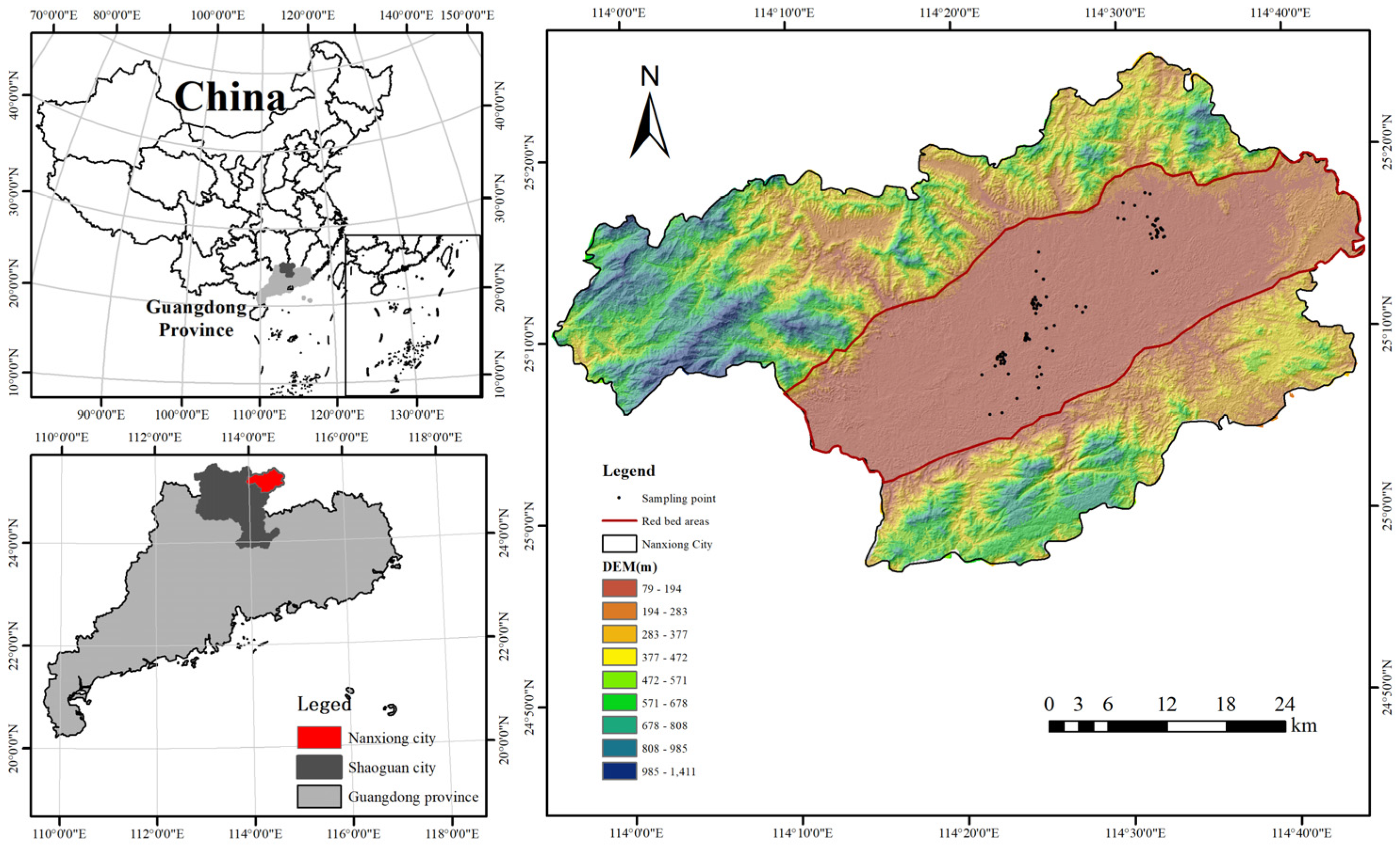
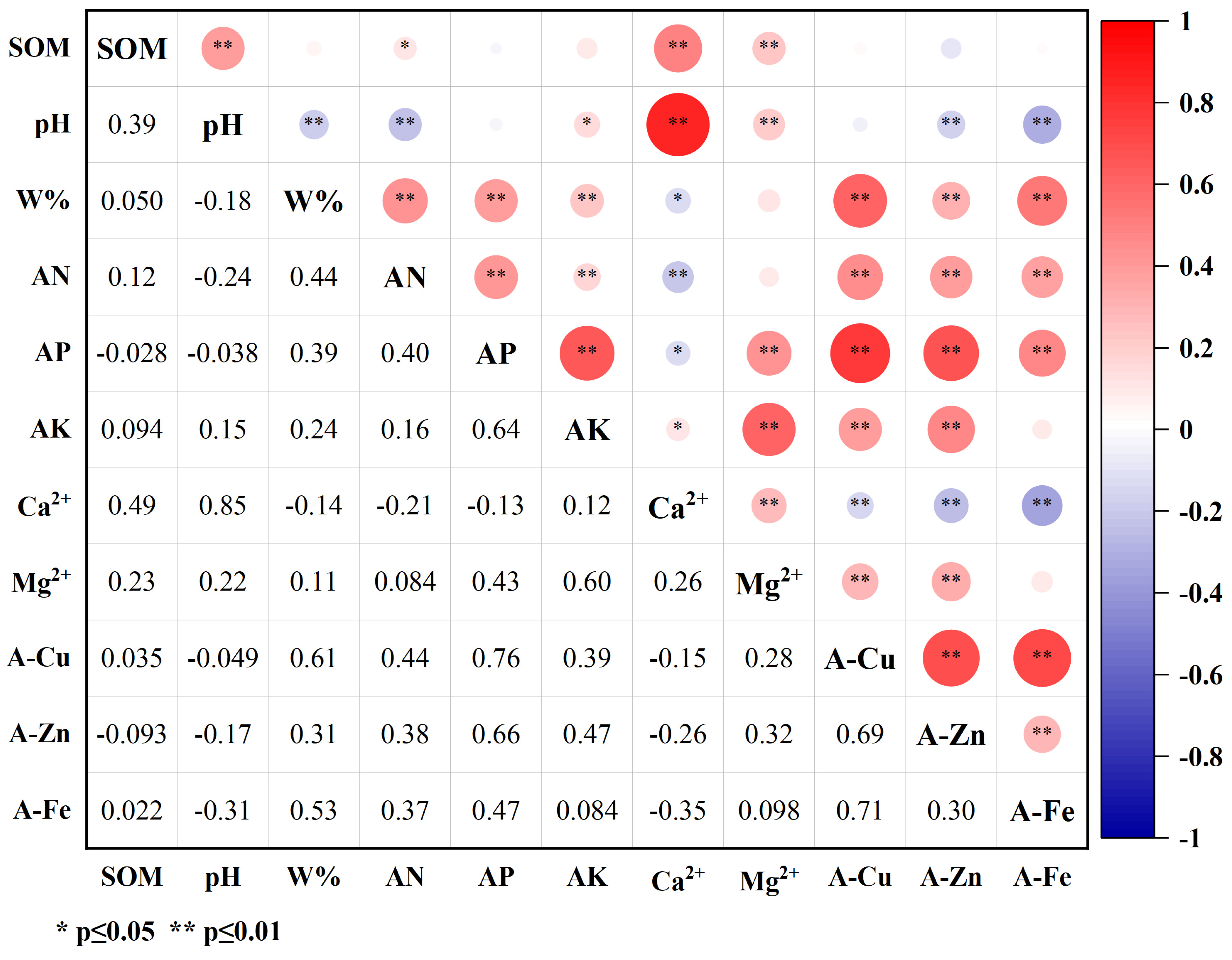
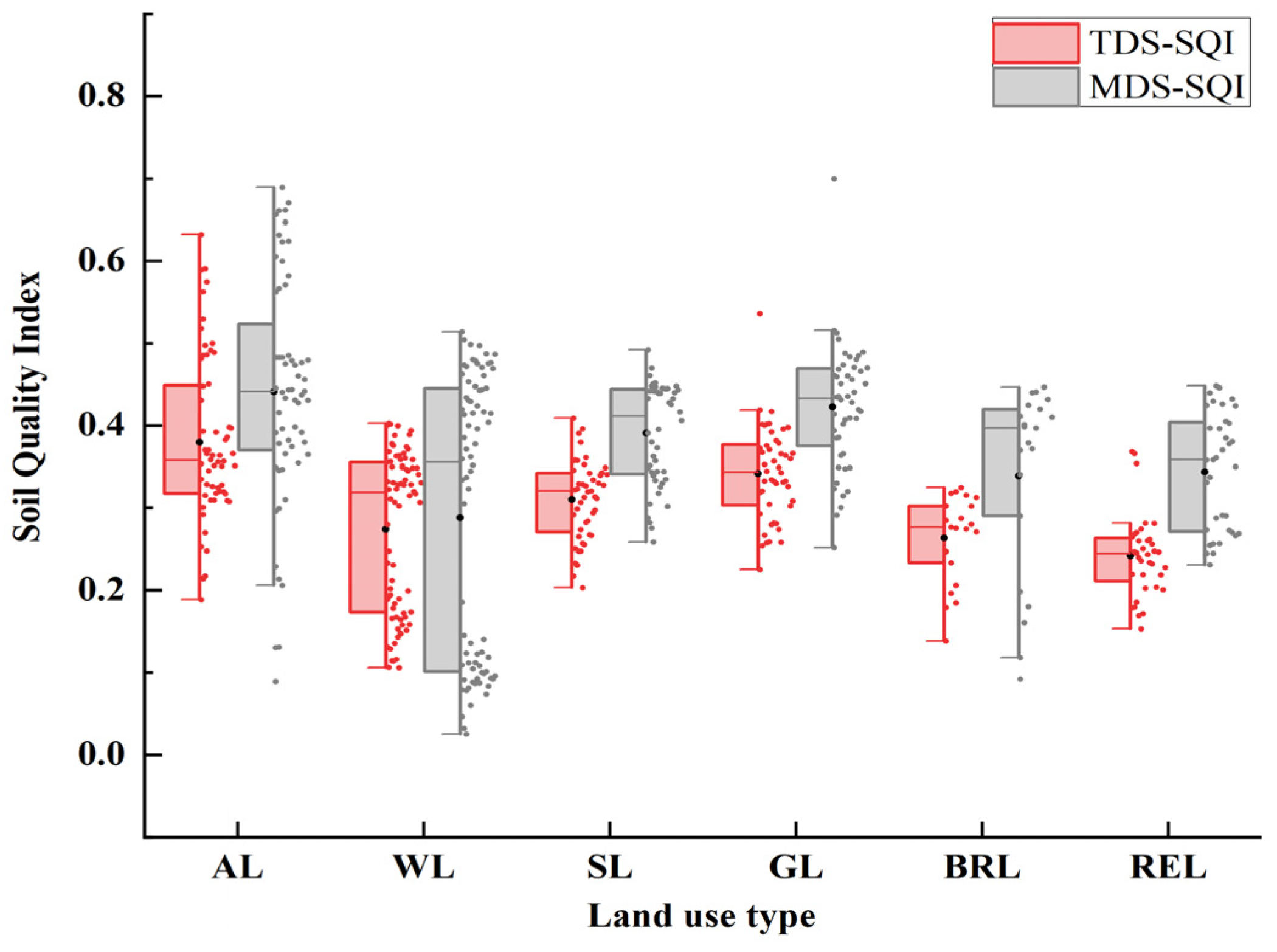
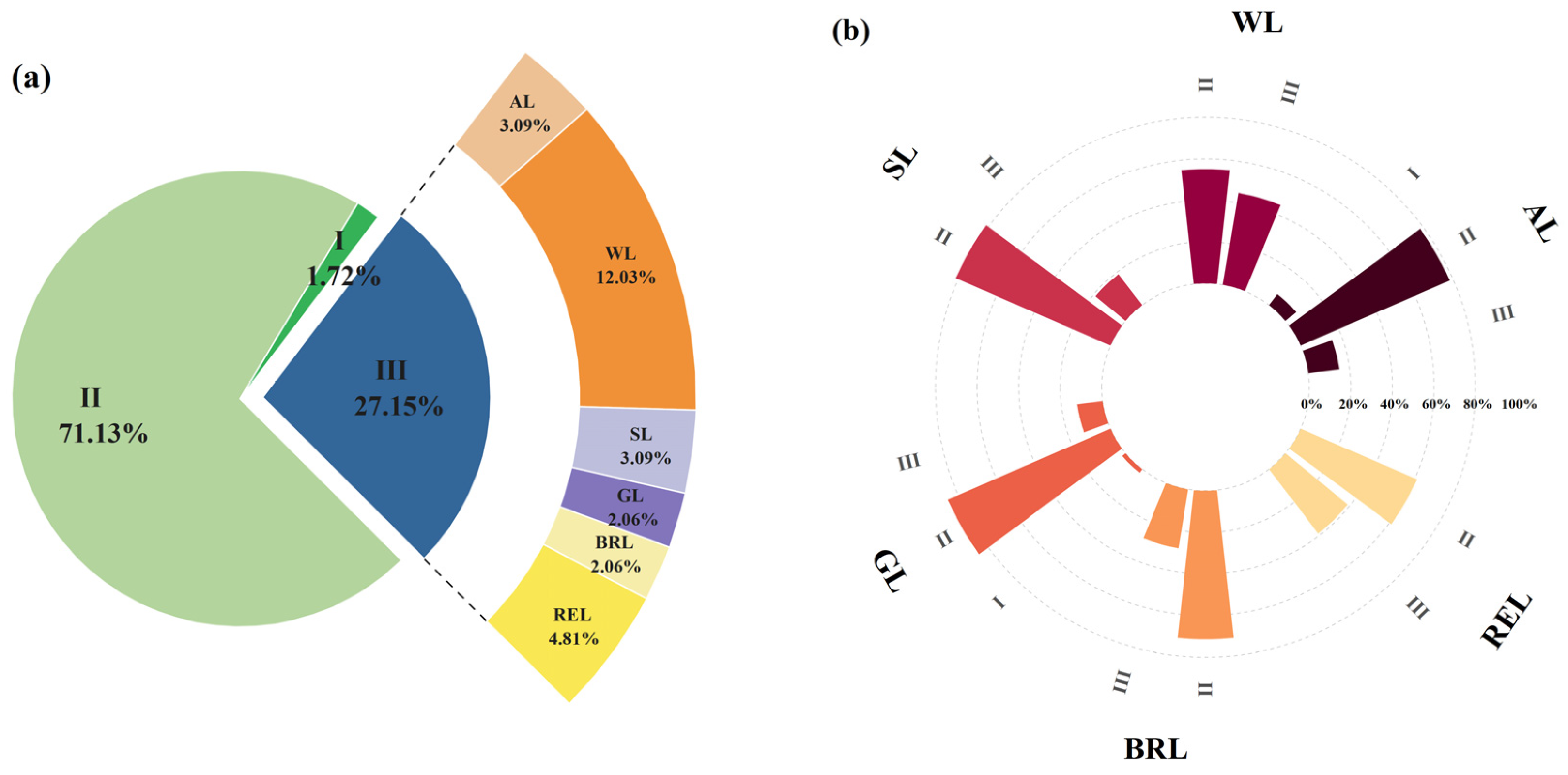
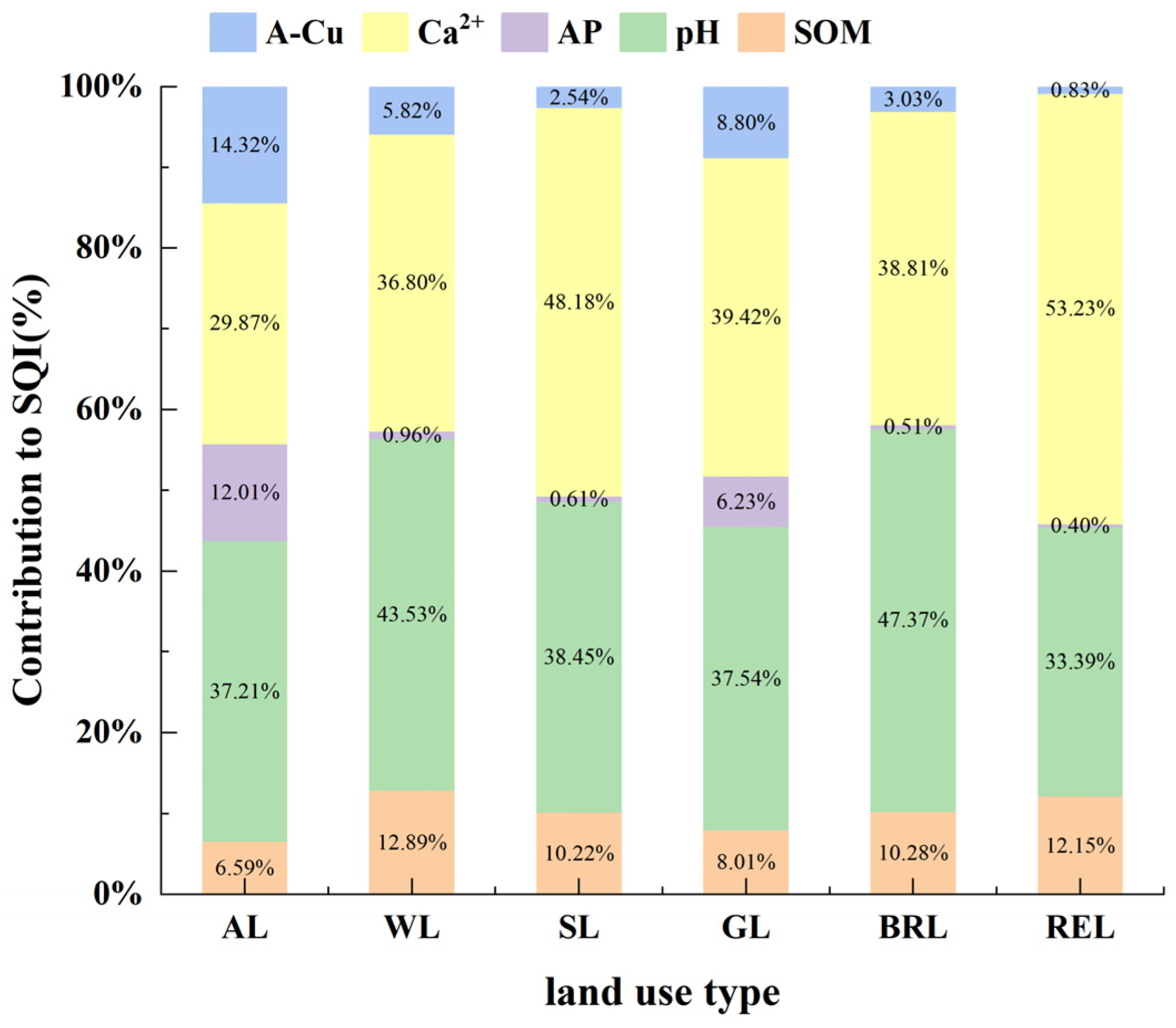
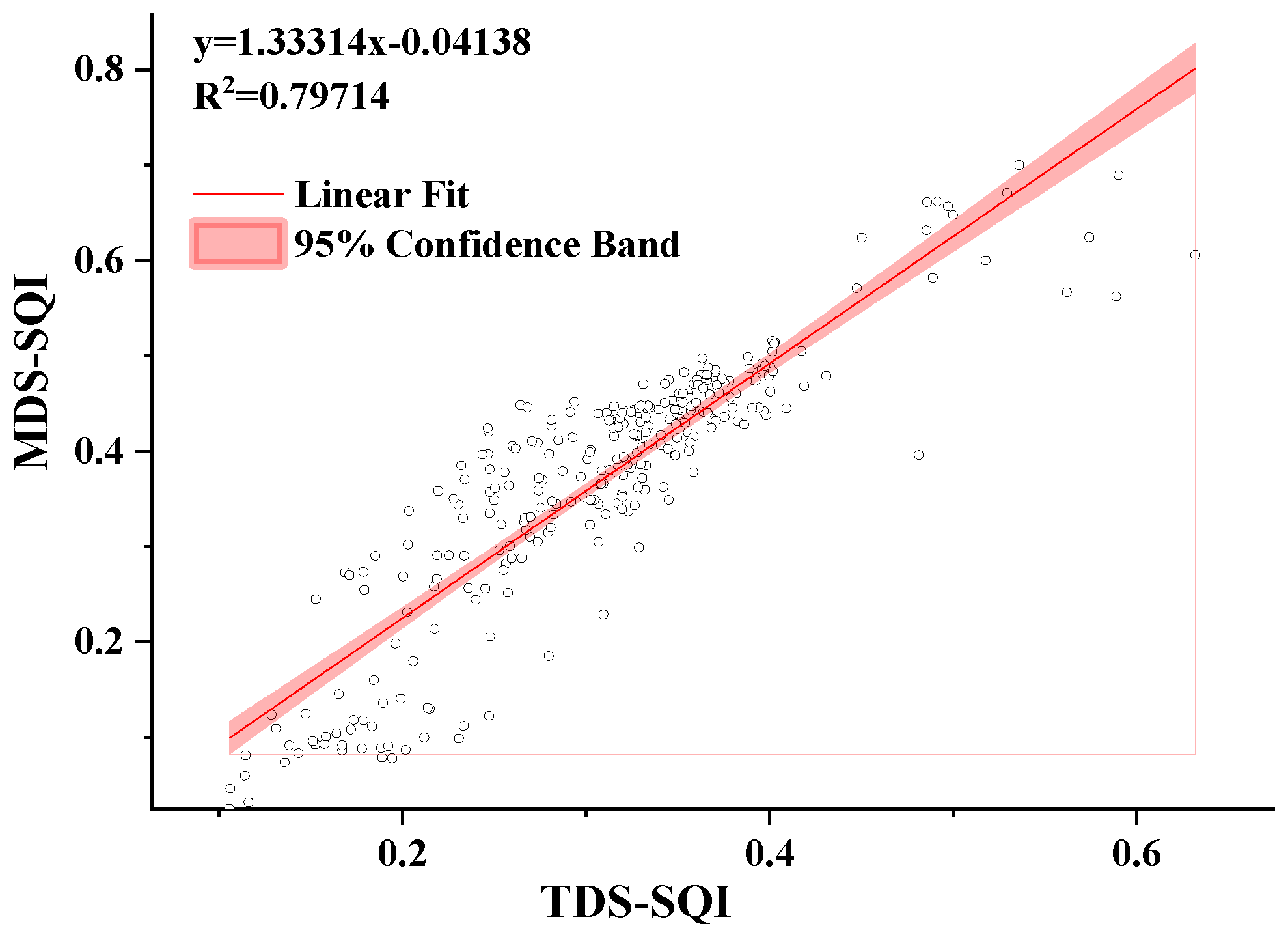
| Land Use Type | Field Photographs | Characteristics |
|---|---|---|
| Agricultural land (AL) | 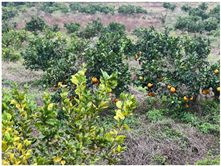 | Plots where Citrus sinensis, Nicotiana tabacum, and Chinese medicinal herbs are cultivated after manual fertilization and irrigation. |
| Woodland (WL) | 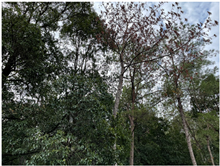 | Primarily includes Pinus massoniana, Acacia confusa, and Leucaena leucocephala. |
| Shrubland (SL) | 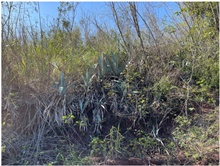 | Plots with low shrubs such as Vitex negundo, Maclura cochinchinensis, and Melia azedarach. |
| Grassland (GL) |  | The vegetation is diverse, with some areas being abandoned agricultural land where grasses such as Agave sisalana, Setaria viridis, and Caryopteris incana naturally grow. |
| Bare rock land (BRL) |  | This area is in the initial stage of natural succession, with only small patches of vegetation cover, predominantly consisting of xerophytic shrubs and grasses. |
| Red bed erosion land (REL) |  | It is an area of severe red bed desertification, characterized by extensive bare ground, sparse vegetation, and, in extreme desertification zones, no plant growth at all. To carry out ecological restoration and prevent soil erosion in the red bed desertification area, experimental soil improvement has been conducted in some red bed erosion areas with extensive bare ground. The primary measure implemented has been the application of organic fertilizer. |
| Evaluate Factors | |||
|---|---|---|---|
| Vegetation Coverage | The Exposed Area Occupies the Total Area | Comprehensive Performance Characteristics | |
| Light desertification | 50%~70% | ≤10% | Erosion gullies are either developed or absent, with the topsoil layer missing. The vegetation is limited, consisting mostly of drought-tolerant shrubs and trees. |
| Moderate desertification | 30%~50% | 10%~25% | Erosion gullies are well developed, but the slopes are generally gentle, with only a small number of shrubs and grasses growing. |
| Severe desertification | 10%~30% | 25%~50% | Erosion gullies are widely distributed, and surface vegetation is scarce, consisting mainly of xerophytic shrubs and grasses. |
| Extreme desertification | ≤10% | ≥50% | The area is characterized by dense erosion gullies, extensive bare land surfaces, sparse vegetation mainly consisting of xerophytes, and an absence of grass in the most extreme areas. |
| Function Type | Membership Function | Evaluation Index | Membership Function Parameter | |||
|---|---|---|---|---|---|---|
| a | m | n | b | |||
| Type of parabolic linear | pH | 4.52 | 7 | 8 | 9.36 | |
| W% | 0 | 8.5% | 15.5% | 55.74% | ||
| Type of S | SOM | 5.99 | 38.50 | |||
| AN | 10.08 | 346.08 | ||||
| AP | 0.03 | 129.54 | ||||
| AK | 24.04 | 735.51 | ||||
| Ca2+ | 50.52 | 8051.00 | ||||
| Mg2+ | 8.12 | 274.50 | ||||
| A-Cu | 0.02 | 3.94 | ||||
| A-Zn | 0.05 | 4.78 | ||||
| A-Fe | 0.37 | 389.39 | ||||
| Type of reverse S | / | |||||
| Land Use Type | SOM (g/kg) | pH | W (%) | AN (mg/kg) | AP (mg/kg) | AK (mg/kg) | Ca2+ (mg/kg) | Mg2 (mg/kg) | A-Cu (mg/kg) | A-Zn (mg/kg) | A-Fe (mg/kg) |
|---|---|---|---|---|---|---|---|---|---|---|---|
| AL | 13.58 ± 6.20 | 7.57 ± 1.03 | 17.26 ± 11.25 | 90.92 ± 66.19 | 31.14 ± 27.32 | 196.58 ± 138.66 | 4760.17 ± 2064.34 | 93.53 ± 48.31 | 1.13± 0.88 | 1.22 ± 0.94 | 41.47 ± 71.63 |
| WL | 15.68 ± 6.23 | 6.86 ± 1.49 | 9.53 ± 4.13 | 65.53 ± 25.47 | 1.66 ± 1.48 | 100.14 ± 50.95 | 3838.73 ± 3169.05 | 66.51 ± 38.69 | 0.31 ± 0.21 | 0.82 ± 0.36 | 18.07 ± 32.40 |
| SL | 16.40 ± 3.72 | 8.31 ± 0.47 | 8.49 ± 3.22 | 33.28 ± 12.70 | 1.42 ± 0.80 | 105.28 ± 38.57 | 6774.34 ± 496.02 | 76.64 ± 33.15 | 0.19 ± 0.09 | 0.45 ± 0.25 | 1.88 ± 1.16 |
| GL | 14.82 ± 4.18 | 8.17 ± 0.54 | 8.59 ± 3.97 | 51.35 ± 11.45 | 15.50 ± 20.18 | 147.21 ± 76.21 | 6002.18 ± 1490.33 | 78.05 ± 31.13 | 0.67 ± 0.37 | 1.03 ± 0.33 | 7.38 ± 7.24 |
| BRL | 15.08 ± 7.68 | 7.37 ± 1.10 | 7.44 ± 3.16 | 42.05 ± 16.29 | 1.04 ± 0.35 | 58.33 ± 16.22 | 4750.24 ± 2525.74 | 40.38 ± 13.77 | 0.20 ± 0.13 | 0.43 ± 0.22 | 5.20 ± 4.78 |
| REL | 16.90 ± 2.64 | 8.60 ± 0.46 | 2.71 ± 1.95 | 16.86 ± 11.72 | 0.84 ± 0.51 | 104.48 ± 28.06 | 6589.87 ± 382.31 | 91.79 ± 61.73 | 0.07 ± 0.04 | 0.11 ± 0.06 | 0.79 ± 0.25 |
| Evaluation Index | Grouping | PCA (Principal Component) | |||
|---|---|---|---|---|---|
| PC1 | PC2 | PC3 | Norm | ||
| W (%) | 1 | 0.660 | −0.073 | 0.424 | 1.417 |
| AN (mg/kg) | 1 | 0.598 | −0.119 | 0.346 | 1.280 |
| AP (mg/kg) | 1 | 0.854 | 0.194 | −0.206 | 1.763 |
| AK (mg/kg) | 1 | 0.572 | 0.496 | −0.438 | 1.480 |
| A-Cu (mg/kg) | 1 | 0.897 | 0.072 | 0.156 | 1.819 |
| A-Zn (mg/kg) | 1 | 0.769 | 0.032 | −0.310 | 1.589 |
| A-Fe (mg/kg) | 1 | 0.691 | −0.251 | 0.393 | 1.514 |
| pH | 2 | −0.257 | 0.835 | 0.124 | 1.430 |
| Ca2+ (mg/kg) | 2 | −0.314 | 0.855 | 0.208 | 1.515 |
| Mg2+ (mg/kg) | 2 | 0.411 | 0.602 | −0.307 | 1.311 |
| SOM (g/kg) | 3 | −0.017 | 0.597 | 0.553 | 1.134 |
| Eigenvalue | 4.058 | 2.519 | 1.269 | / | |
| Percentage of explained variance/% | 36.887 | 22.896 | 11.532 | / | |
| Cumulative explanation percentage/% | 36.887 | 59.783 | 71.315 | / | |
| Indicators | TDS | MDS | ||
|---|---|---|---|---|
| Communality | Weight | Communality | Weight | |
| SOM (g/kg) | 0.662 | 0.084 | 0.493 | 0.125 |
| pH | 0.779 | 0.099 | 0.819 | 0.207 |
| W (%) | 0.621 | 0.079 | ||
| AN (mg/kg) | 0.491 | 0.063 | ||
| AP (mg/kg) | 0.809 | 0.103 | 0.873 | 0.221 |
| AK (mg/kg) | 0.765 | 0.098 | ||
| Ca2+ (mg/kg) | 0.873 | 0.111 | 0.886 | 0.224 |
| Mg2+ (mg/kg) | 0.626 | 0.080 | ||
| A-Cu (mg/kg) | 0.833 | 0.106 | 0.883 | 0.223 |
| A-Zn (mg/kg) | 0.689 | 0.088 | 0.493 | 0.125 |
| A-Fe (mg/kg) | 0.695 | 0.089 | ||
Disclaimer/Publisher’s Note: The statements, opinions and data contained in all publications are solely those of the individual author(s) and contributor(s) and not of MDPI and/or the editor(s). MDPI and/or the editor(s) disclaim responsibility for any injury to people or property resulting from any ideas, methods, instructions or products referred to in the content. |
© 2024 by the authors. Licensee MDPI, Basel, Switzerland. This article is an open access article distributed under the terms and conditions of the Creative Commons Attribution (CC BY) license (https://creativecommons.org/licenses/by/4.0/).
Share and Cite
Si, F.; Chen, B.; Wang, B.; Li, W.; Zhu, C.; Fu, J.; Yu, B.; Xu, G. Soil Quality Assessment and Influencing Factors of Different Land Use Types in Red Bed Desertification Regions: A Case Study of Nanxiong, China. Land 2024, 13, 1265. https://doi.org/10.3390/land13081265
Si F, Chen B, Wang B, Li W, Zhu C, Fu J, Yu B, Xu G. Soil Quality Assessment and Influencing Factors of Different Land Use Types in Red Bed Desertification Regions: A Case Study of Nanxiong, China. Land. 2024; 13(8):1265. https://doi.org/10.3390/land13081265
Chicago/Turabian StyleSi, Fengxia, Binghui Chen, Bojun Wang, Wenjun Li, Chunlin Zhu, Jiafang Fu, Bo Yu, and Guoliang Xu. 2024. "Soil Quality Assessment and Influencing Factors of Different Land Use Types in Red Bed Desertification Regions: A Case Study of Nanxiong, China" Land 13, no. 8: 1265. https://doi.org/10.3390/land13081265








